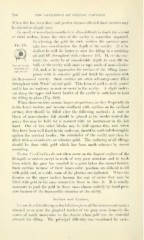Page 286 - My FlipBook
P. 286
284 THE OPERATION OF FILLING CAVITIES.
When this has been done and perfect dryness effected these cavities may
be classed as simple ones.
In small or non-elastic months it is often difficnlt to reach the second
or tliird molars, hence the view of the cavity is somewhat impaired.
In selectin<>; the gold for snch cavities the <)})erator mnst
Img. 240.
{i\\;,Q into consideration the depth of the cavity. If it be
shallow he will do better to start his fillinji; in a retaining;
pit and fill throutrhont with cohesive foil. If, on the con-
trary, the cavity be of considerable depth, he may fill the
Buccal cavity bulk of the cavlty with mats or tape m^ade of non-cohesive
in lower sec-
^^ j^^ approaches the snrface of the
^^^j] ,^j^^ ... fillino:, incor-
ond molar. , . . . .
porate with it cohesive gold and finish his operation with
the last-named variety. Snch cavities are often advantageously filled
throughout with Watts' crystal gold. This form of gold is easily seated
and it has no tendency to rock or move in the cavity. A slight under-
cut along the upper and lower border of the cavity is sufficient to hold
the filling in place (Fig. 240).
When these cavities assume larger proportions, as they frequently do
in the k)wer molars, and become confluent with cavities on the occlusal
surface, they should be filled after the following method A mat or
:
block of non-cohesive foil should be placed at the border nearest the
gum ; this may be held for a moment with an instrument in the left
hand. One or two other blocks may be laid against this, and, Mdien
they have been well fixed in the undercut, should be malleted thoroughly
against the cervical border ; the remainder of the cavity may then be
filled with semi-cohesive or cohesive gold. The surfacing of all fillings
should be done with gold which has been made cohesive by recent
annealing.
Class C.—Cavities do not often occur on the lingual surfaces of the
bicuspids or molars except in teeth of very poor structure and in teeth
from which the gum has receded to a point below the enamel border.
Such cavities because of their inaccessible position are difficult to fill
with gold, and, as a rule, some of the plastics are indicated. When the
fissures on the upper molars become the seat of caries they may be
filled with gold in the same manner as those in class B. It is usually
necessary to pack the gold in these cases almost entirely by hand pres-
sure because of the inaccessible situation of the cavity.
Incisors and Canines.
Class D.—Cavities upon the labial surfaces of the incisors and canines
situated at or near the gingival border of the gum were formerly the
source of much annoyance to the dentist when gold was the material
selected for filling. The principal difficulty was occasioned by moi.s-


